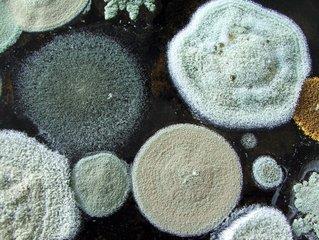Health Risks of Moulds
Problems of indoor air quality are recognized as important risk factors for human health. Indoor air is also important because populations spend a substantial fraction of time within buildings. In residences, day-care centres, retirement homes and other special environments, indoor air pollution affects population groups that are particularly vulnerable due to their health status or age. Microbial pollution involves hundreds of species of bacteria and fungi that grow indoors when sufficient moisture is available. Exposure to microbial contaminants is clinically associated with respiratory symptoms, allergies, asthma, and immunological reactions.

Basic Facts about Mould and Dampness
The presence of many biological agents in the indoor environment is due to dampness and inadequate ventilation. Excess moisture on almost all indoor materials leads to growth of microbes, such as mould, fungi, and bacteria, which subsequently emit spores, cells, fragments, and volatile organic compounds into indoor air. Moreover, dampness initiates chemical or biological degradation of materials, which also pollutes indoor air. Dampness has therefore been suggested to be a strong, consistent indicator of risk of asthma and respiratory symptoms (e.g., cough and wheeze). The health risks of biological contaminants of indoor air could thus be addressed by considering dampness as the risk indicator.
Microbial pollution is a key element of indoor air pollution. It is caused by hundreds of species of bacteria and fungi, in particular filamentous fungi (mould), growing indoors when sufficient moisture is available.
The World Health Organization estimates indoor dampness, which is a major factor in the growth of moulds in the home, may affect between 10 and 50 per cent of indoor settings across Australia.
What are the health risks of mould?
To reproduce, mould spawns’ tiny particles called spores which are carried in the air.
Not all people are adversely affected by mould. However, it can emit particles that may cause some people to sneeze. This is not necessarily an allergy; like a dust storm, it is a reaction to the particles in the air. Often, moulds can also release a musty odour which can be disagreeable. Toxic moulds produce mycotoxins that can pose serious health risks. Some studies claimed that exposure to high levels of mycotoxins can lead to neurological problems and in some cases death. Prolonged exposure may be particularly harmful.
Research in this area has not been conclusive. Symptoms caused by mould allergy may include:
- Respiratory illness or asthma;
- • Watery, itchy, red eyes;
- • Chronic cough;
- Headaches or migraines;
- • Rashes (dermatitis);
- • Tiredness;
- Sinus problems, blocked nose;
- • Frequent sneezing;
This fact sheet link below provides information on what mould is, how mould can affect your health, and on how to reduce the potential hazard associated with mould growth within your home.
FACT SHEETS: www.health.nsw.gov.au/environment/factsheets/Pages/mould.aspx
The conversation in Australia is slowly changing when it comes to both understanding and acknowledging adverse health effects in susceptible individuals from innate immune activation following exposure to indoor dampness and mould.
Chronic Inflammatory Response Syndrome (CIRS) is a multi-system, multi-symptom illness caused by inhaling biotoxins and inflammagens produced by micro-organisms such as mould, bacteria, and actinomycetes found in water-damaged buildings.
Chronic Inflammatory Response Syndrome Explained
A Science Primer on Multi-System, Multi-Symptom Illness from Dampness & Mould




